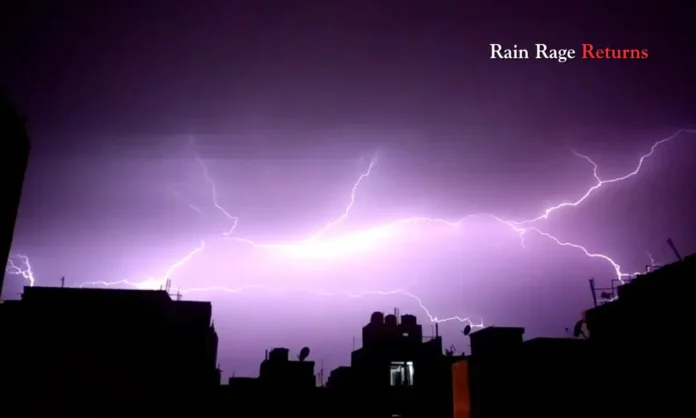Summary
- IMD forecasts persistent Delhi thunderstorms August 2025, with rain likely till August 3.
- Temperature remains below average, improving AQI levels across NCR.
- July saw higher-than-normal rainfall, delaying monsoon withdrawal predictions.
A Shifting Monsoon Pattern Unfolds
The seasonal landscape of Delhi is being rewritten by the continuing Delhi thunderstorms August 2025, as the capital enters yet another stretch of rain and thundershowers. According to the India Meteorological Department (IMD), light to moderate rain with isolated thunderstorms will dominate the city’s weather till at least August 3.
The IMD’s alerts on Delhi thunderstorms August 2025 have come amid already soaked streets, power disruptions, and altered city routines. The pattern suggests more than an isolated wet phase—it points toward shifting climate dynamics affecting the region more deeply than in previous years.
Commuters have adjusted their schedules, schools have issued warnings, and emergency services remain on alert. While Delhiites are used to chaotic monsoons, the Delhi thunderstorms August 2025 have brought an unusual consistency and intensity in both precipitation and thunderstorm frequency.
An Extended Wet Spell: What the Forecast Says
- Delhi to witness more cloudy days and high moisture conditions due to prevailing wind patterns.
- IMD attributes the persistence of Delhi thunderstorms August 2025 to Bay of Bengal flows and weakened monsoon troughs.
IMD forecasts highlight an active system pushing daily rain showers across Delhi and adjoining areas. The resulting Delhi thunderstorms August 2025 have been driven by deep convective clouds and regional instability from a stalled monsoon trough near the Himalayan foothills. This system is expected to linger over the next few days.
On July 30, the Safdarjung weather station recorded a rainfall total exceeding 235 mm, surpassing the July average of 209 mm. These levels validate the IMD’s warning of intensified Delhi thunderstorms August 2025, especially across southern and eastern zones like Lajpat Nagar, Okhla, and Mayur Vihar.
The IMD has advised caution for commuters, with alerts on thunderstorm-linked gusty winds and reduced visibility continuing through early August. As per the latest radar images, isolated strong cells continue to develop in western NCR, indicating further thunderstorm risk.
Decoding the Rain: Emerging Patterns and Impacts
- Air quality improves remarkably amid continuous rainfall.
- The Delhi thunderstorms August 2025 have disrupted road infrastructure and civic services.
Though monsoon rains often paralyze infrastructure, the Delhi thunderstorms August 2025 have also brought significant short-term environmental benefits. Delhi’s notorious Air Quality Index (AQI), which hovered near 120 in early July, dropped into the “satisfactory” range—between 59 and 66—in the last week of the month. Experts credit this to the atmospheric cleansing caused by persistent rain.
However, the upside is met with operational challenges. The Delhi thunderstorms August 2025 led to temporary power outages in Dwarka and Shahdara, and over 170 complaints of waterlogging were received by the Municipal Corporation of Delhi (MCD) in just two days.
Key arterial roads such as Ring Road and Aurobindo Marg were partially flooded due to blocked stormwater drains. The Transport Department reported a 21% surge in average peak-hour travel time, a direct fallout of the prolonged Delhi thunderstorms August 2025.
A Closer Look: Why This August Feels Different
- The intensity of Delhi thunderstorms August 2025 comes on the heels of an unusually dry June.
- Experts cite early warning signals of monsoon irregularities tied to urban climate stress.
The recent frequency of Delhi thunderstorms August 2025 is not a mere weather anomaly. It represents a rising pattern of seasonal shifts impacted by climate change. June 2025 was marked by a 29% rainfall deficit, while July saw extreme swings—first dry heat, then heavy cloudbursts.
According to a study by the Indian Institute of Tropical Meteorology, Delhi is seeing clustered rain events caused by micro-climatic effects such as heat islands and aerosol concentration. These local factors intensify thunderstorm activity, which is evident in the current Delhi thunderstorms August 2025.
Meanwhile, the IPCC’s Sixth Assessment Report has warned of a 20–30% rise in monsoon variability for north Indian metros like Delhi. If planning and policy don’t adapt, episodes like the Delhi thunderstorms August 2025 will likely become more disruptive and frequent.
The Road Ahead: What to Expect This Monsoon
- IMD models suggest rain activity could reappear in Delhi around August 8–10.
- The Delhi thunderstorms August 2025 could prolong monsoon departure timelines.
Although this spell may weaken after August 3, IMD’s extended models indicate another trough may trigger further Delhi thunderstorms August 2025 by mid-August. The possibility of a secondary wet phase cannot be ruled out, particularly if low-pressure systems over eastern UP and Bihar extend westward.
Nighttime temperatures in Delhi have stayed consistently below 25 °C, about 1–2 °C lower than usual. This cooler trend, driven by persistent rain, delays the normal withdrawal trajectory of the monsoon, which typically begins in early September.
For civic planners, these trends call for a renewed urgency. Drainage modernization, real-time weather data systems, and emergency response mobilization will be essential if the Delhi thunderstorms August 2025 pattern persists beyond mid-month.
Weathering the Storm: A Final Word
The extended spell of Delhi thunderstorms August 2025 presents a mirror to the city’s future. It is no longer sufficient to prepare for weather; Delhi must prepare for weather unpredictability. From improved AQI to flooded roads, this monsoon has shown both nature’s generosity and its warnings.
As Delhi navigates the rest of its rainy season, the lessons from the Delhi thunderstorms August 2025 must shape policy, planning, and public awareness. Whether it’s infrastructure resilience or health readiness, the storm is not just above our heads—it is in our decisions.


